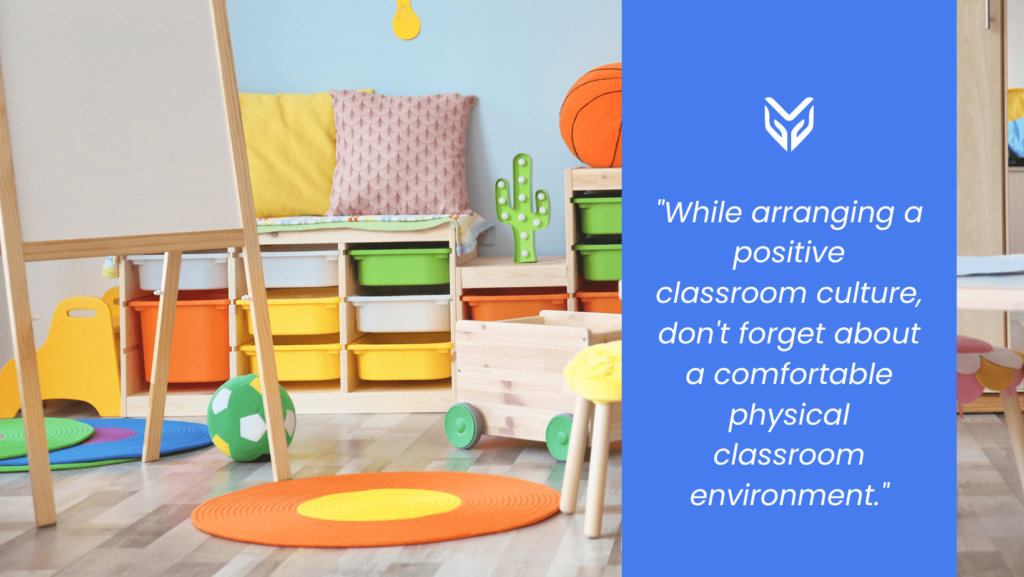NEWS
Tips for Creating a Positive Classroom Culture

Today, we know very well that classrooms are much more than places of mere learning. All of the things students are surrounded with play a part in how they learn, and teachers are aware that fostering a positive classroom culture and environment helps students feel safe and motivated.
So, the goal is to create a positive classroom and school environment where students feel safe and respected. Besides successful learning, the ultimate goal is ensuring that students perceive school grounds as a safe space and return there daily, knowing they will be taken care of and valued.
We can label a classroom environment as positive when students feel comfortable speaking out, asking questions, and taking chances. Research shows that the learning environment can stimulate students’ engagement in the learning process and influence their behavior.
Read on to discover six tips that will assist you in creating a positive learning environment.

Get To Know Your Students and Build Meaningful Relationships With Students and Parents
Discovering your students’ hobbies and backgrounds can help you get to know them as individuals. As a result, you will understand each student better and be able to establish a positive classroom culture where they feel appreciated and at home.
You can learn a lot about them through simple observation, attending to each of them individually and regularly, and actively listening to what they want to share with you.
Foster Positive Connections Between Students
Community-building activities are too often reserved only for the start of the school year. Make sure you organize student-bonding activities throughout the year and give the students a chance to bond in ways with which they are comfortable. With it, you can also introduce them to situations that normally wouldn’t be a part of regular class work. Pick community-building activities such as hot seat, rock-paper-scissors tag, and spider web, and watch your students form beautiful bonds and groom their social skills.

Set Clear Rules and Provide Positive Reinforcement
One of the keys to establishing a positive classroom culture is setting clear guidelines, which set the tone for the class. You can also involve your students in establishing these rules. At the same time, make sure everyone understands the consequences of breaking the rules. Simultaneously, also ensure the opposite. Reward the students who abide by the rules and, with it, encourage them so they realize the importance of respecting set norms.
Make Sure To Arrange a Positive Physical Environment
While arranging a positive classroom culture, don’t forget about a comfortable physical classroom environment. It is essential for creating a safe and nurturing learning experience. According to the National Center on Safe Supportive Learning Environments, the physical environment creates a positive school climate in which students can learn. Everything from lighting to indoor air quality, ambient noise, and thermal control of the school’s areas matters.

The needs of students, teachers, and staff should all be considered – and while planning it, don’t forget about safety. Besides ensuring the classroom is appropriately heated, ventilated, lighted, and so on, also take care of the details. Use comfortable furniture and calming and inviting colors, such as blues and greens, exhibit artwork and decorations, and so on.
Establish a Routine
Establishing a routine helps students learn better, reduces distractions, builds a sense of community, and allows you to focus on teaching. Therefore, it is essential to establish a daily classroom routine that is known and easily understandable to students. Using classroom monitoring tools is very helpful in achieving that – since many tools allow functions like classroom screen monitoring, student safety, jointly sharing information and content on screens, keeping tabs on students’ feedback, and so on.
Keep a Positive Mindset
While it could be said teaching is one of the most beautiful professions, it can be very exhausting and draining. Because of the demands and expectations within and outside of school, taking time for yourself is crucial. Make sure you care for yourself and your mental and physical health. You need it to give the students your best. While setting clear boundaries, also set realistic expectations for both you and your students. Take breaks when you need them, and most importantly – never dwell on your failures, but instead, celebrate your victories and the teaching successes you are achieving daily.
Using some or all of these tips, you can create a classroom culture conducive to learning and growth. Establishing a positive classroom environment promotes growth and respect and makes learning easier and more fun!
SOURCES
[1] Amirul, N. J., Ahmad, C. N., Yahya, A. F., Abdullah, M. F. N. L., Noh, N. M., & Adnan, M. (2013). The physical classroom learning environment. In Proceedings of the International Higher Education Teaching and Learning Conference (Vol. 2, No. 1, pp. 1-9).





